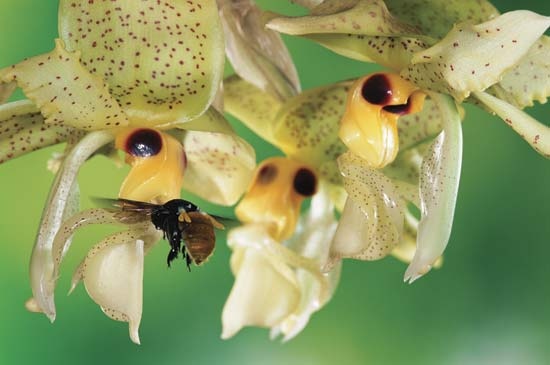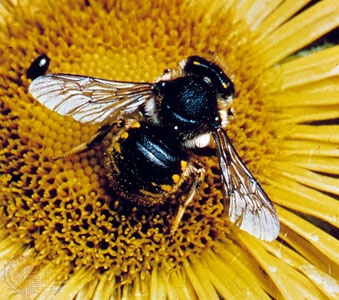bee
insect
 any of more than 20,000 species of insects in the suborder Apocrita (order Hymenoptera) that includes the familiar honeybee (Apis) and bumblebee (Bombus and Psithyrus), as well as thousands more wasplike and flylike bees. Adults range in size from about 2 mm to 4 cm (about 0.08–1.6 inch).
any of more than 20,000 species of insects in the suborder Apocrita (order Hymenoptera) that includes the familiar honeybee (Apis) and bumblebee (Bombus and Psithyrus), as well as thousands more wasplike and flylike bees. Adults range in size from about 2 mm to 4 cm (about 0.08–1.6 inch).Bees are closely related to certain types of wasps (wasp), with the principal biological difference between them being that bees (except for parasitic bees) provide their young with a mixture of pollen and honey, whereas wasps feed their young animal food or provision their nests with insects or spiders. Associated with this difference in food preference are certain structural differences, the most essential being that wasps are covered with unbranched hairs, whereas bees have at least a few branched or feathered hairs to which pollen often clings.
 Bees are entirely dependent on flowers for food, which consists of pollen and nectar, the latter sometimes modified and stored as honey. There is no doubt that bees and the flowers that they pollinate evolved simultaneously. As bees go from flower to flower gathering pollen, a small amount is rubbed from their bodies and deposited on the flowers they visit. This loss of pollen is significant, for it often results in cross-pollination of plants. The practical value of bees as pollinators is enormously greater than the value of their honey and wax production.
Bees are entirely dependent on flowers for food, which consists of pollen and nectar, the latter sometimes modified and stored as honey. There is no doubt that bees and the flowers that they pollinate evolved simultaneously. As bees go from flower to flower gathering pollen, a small amount is rubbed from their bodies and deposited on the flowers they visit. This loss of pollen is significant, for it often results in cross-pollination of plants. The practical value of bees as pollinators is enormously greater than the value of their honey and wax production.Male bees are usually short-lived and never collect pollen, nor do they have other responsibilities in connection with providing for the young. Female bees do all the work of nest making and provisioning and usually have special anatomical structures that assist them in carrying pollen. Most bees are polylectic, meaning that they gather pollen from a wide variety of flowers. However, some bees collect pollen only from flowers of certain families, others from flowers of certain colours. Oligolectic bees gather pollen from only a few related kinds of flowers. The mouth parts of bees, like the pollen-collecting and pollen-carrying devices, seem to be adapted to different flowers.
Most of the Apoidea are solitary, or nonsocial, in habit and do not live in colonies. In these species each female makes her own nest (usually a burrow in the ground) and provisions it. Among such bees there are no castes. Some solitary bees make chimneys or turrets at the nest entrance, others nest in wood or in the pith of twigs or canes. Most solitary bees are short-lived as adults. Some species may be in flight only a few weeks of the year, having spent the rest of the year in their cells as eggs, larvae, pupae, and young adults.
Solitary bees provide all of the food the larvae require to complete development when the cells are sealed. Social bees, such as the bumblebee and the honeybee, feed their young progressively. For the life cycle of social bees, see bumblebee; honeybee.
 The Apoidea includes eight families: Colletidae, which are primitive wasplike bees consisting of five or six subfamilies, about 45 genera, and some 3,000 species; Andrenidae, which are medium-sized solitary mining bees, including some parasitic species; Halictidae (mining, or burrowing, bees), the best-known of which is Dialictus zephyrus, one of many so-called sweat bees, which are attracted to perspiration; Oxaeidae, large, fast-flying bees that bear some anatomical resemblance to Andrenidae; Melittidae, bees that mark a transitional form between the lower and the higher bees; Megachilidae (leaf-cutter bee) (leaf-cutting 【see photograph-->
The Apoidea includes eight families: Colletidae, which are primitive wasplike bees consisting of five or six subfamilies, about 45 genera, and some 3,000 species; Andrenidae, which are medium-sized solitary mining bees, including some parasitic species; Halictidae (mining, or burrowing, bees), the best-known of which is Dialictus zephyrus, one of many so-called sweat bees, which are attracted to perspiration; Oxaeidae, large, fast-flying bees that bear some anatomical resemblance to Andrenidae; Melittidae, bees that mark a transitional form between the lower and the higher bees; Megachilidae (leaf-cutter bee) (leaf-cutting 【see photograph--> 】 and mason bees), noted for their elaborate nest structures; Anthophoridae (including carpenter bees and cuckoo bees), a large family that includes three subfamilies that were once considered to be subfamilies of Apidae; and Apidae (bumblebees, honeybees, and digger, or mining, bees).
】 and mason bees), noted for their elaborate nest structures; Anthophoridae (including carpenter bees and cuckoo bees), a large family that includes three subfamilies that were once considered to be subfamilies of Apidae; and Apidae (bumblebees, honeybees, and digger, or mining, bees).The so-called killer bee is a hybrid between an African subspecies and European subspecies of honeybee. The Africanized honeybee subspecies was accidentally released in Brazil in 1957 during an attempt to create a hybrid that would adapt to tropical climates and produce large amounts of honey. Moving northward some 200 to 300 miles (320 to 480 km) per year, the bees had reached Mexico in the 1980s and Texas by 1990. Their range today covers the greater part of the southwestern United States, including southern California, southern Nevada, and all of Arizona. In addition, an increasing number of Africanized honeybees have been observed in Florida. They have been considered responsible for hundreds of deaths. The Africanized honeybee is smaller and much less effective in pollination of plants than its European counterpart. Although it is not more venomous than the European form, it reacts much more quickly to perceived threats to the colony, attacks in number, pursues for a longer time and greater distance, and takes longer to calm down.
- baron de Gerlache de Gomery, Adrien-Victor-Joseph
- baron de Gerlache, Étienne-Constantin
- baron de Hirsch, Maurice
- baron de Jomini, Henri
- baron de La Brède et de Montesquieu, Charles-Louis de Secondat
- baron de Lahontan, Louis-Armand de Lom d'Arce
- baron de l'Aulne Turgot, Anne-Robert-Jacques
- baron de Marbot, Jean-Baptiste-Antoine-Marcelin
- Baron de Montmorency, Mathieu II
- Baron Denon, Dominique Vivant
- baron des Adrets, François de Beaumont
- Baron Desnoyers, Auguste-Gaspard-Louis
- baron d' Holbach, Paul-Henri Dietrich
- Baron Du Casse, Pierre-Emmanuel-Albert
- Baron Dupuytren, Guillaume
- Baron Duveen of Millbank, Joseph Duveen
- Barone, Enrico
- Baron Ensor, James
- Barone Sonnino, Sidney
- Baroness Amos of Brondesbury Amos, Valerie Ann
- Baroness Burdett-Coutts, Angela Georgina Burdett-Coutts
- Baroness de Feuchères, Sophie Dawes
- Baroness Emmuska Orczy
- Baroness (Freifrau) von Ebner-Eschenbach, Marie
- Baroness Masham Of Otes Masham, Abigail